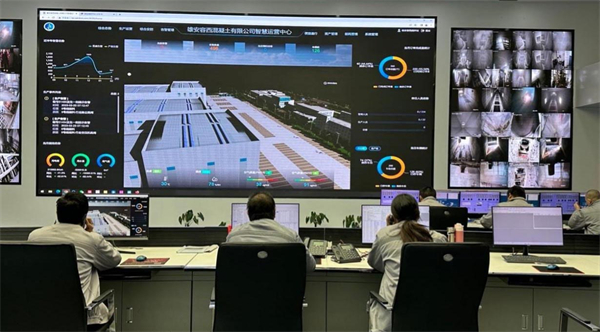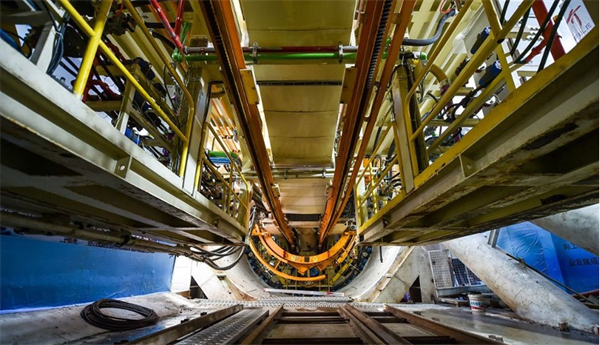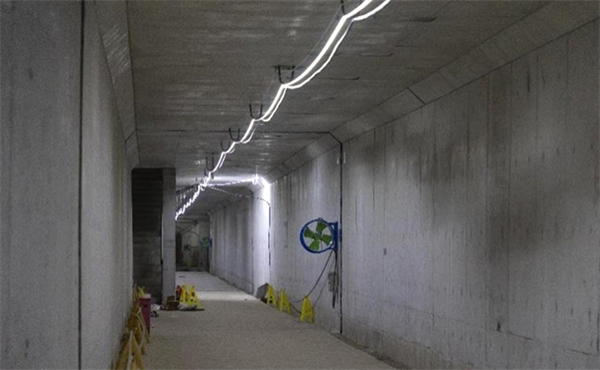
- Home
- Media Center
-
Events
- Wuzhen Summit
- Regional Forums
- Practice Cases of Jointly Building a Community with a Shared Future in Cyberspace
- World Internet Conference Awards for Pioneering Science and Technology
- The Light of Internet Expo
- Straight to Wuzhen Competition
- Global Youth Leadership Program
- WIC Distinguished Contribution Award
- Membership
- Research & Cooperation
- Digital Academy
-
Reports
- Collection of cases on Jointly Building a Community with a Shared Future in Cyberspace
- Collection of Shortlisted Achievements of World Internet Conference Awards for Pioneering Science and Technology
- Reports on Artificial Intelligence
- Reports on Cross—Border E—Commerce
- Reports on Data
- Outcomes of Think Tank Cooperation Program
- Series on Sovereignty in Cyberspace Theory and Practice
- Other Achievements
- About WIC
- 中文 | EN

Smart construction thrives in China's Xiong'an New Area

Photo shows a smart operating center of a concrete mixing plant of China MCC22 Group Corporation Ltd. in Xiong'an New Area, north China's Hebei province. [Photo from China.com.cn]
Concrete batching plants always give the impression of thick dust, sewage and noise. However, this is not the case for the one owned by Chinese construction engineering company China MCC22 Group Corporation Ltd. in Xiong'an New Area, north China's Hebei province.
Right beside the plant is a beautiful forest. The workshops there are as quiet as office buildings and the cleanliness of the ground reminds everyone of basketball floors.
According to An Huajie, director of the digital center of the Xiong'an branch of China MCC22 Group Corporation Ltd., the plant has shattered the record in daily production among all concrete batching plants across China.
Xiong'an New Area, which is established to undertake the noncapital functions of Beijing, is currently under construction in full swing. Intelligent construction technologies have been employed in a number of engineering projects there.
Concrete production at the plant is fully automatic and needs no manual operation. In a smart operating center, there is a big screen that shows real-time information about the seven production lines of the plant. The center is unattended and the production is totally emission-free. The takt time of the plant can be controlled in a millisecond time scale.
Production efficiency has been increased by 3 times while the amount of labor used is cut by 90 percent, An said. The plant has also developed a mobile application that makes concrete ordering as easy as ordering food online.
"We supply over 10 percent of the concrete used in Xiong'an New Area, and our products are seen at over 100 construction sites here," he told People's Daily.
Apart from modern buildings, what's beneath the ground in Xiong'an New Area is surprising, too. To bid farewell to overhead cable networks and frequent road patching that were once a headache in urban management, facilities of water and power supply, gas pipes, heat network and communication cables are all buried in underground pipe galleries in Xiong'an nowadays.
"The galleries are two-storied. Cars can even run on the upper logistics story," said Huang Ji, technical head of the Rongdong section of the underground pipe gallery project from China MCC20 Group Corporation Ltd.
However, this advanced design was also a challenge for construction. The depth of foundation pits reached over 20 meters at some points, which meant an excavation of over 1.3 million cubic meters, more than enough to fill up 17,000 twenty-foot equivalent units.
To ensure reliable and rapid construction, China MCC20 Group Corporation Ltd. employed photogrammetry and building information modeling, which obtained elevations through drone cameras, built data models and calculated the earth volume. With the help of these frontier technologies, an optimal excavation plan was selected, which cut construction period by a month.
Smart construction is also making construction sites safer. "There are 39 buildings, eight supporting facilities for public services, and two schools. They are expected to be finished within 15 months," said Chen Zhiguo, site manager of a resettlement project in Xiong'an New Area contracted by Shanghai Baoye Group Corp., Ltd.
The project is assisted by a number of smart devices. For example, the spray system on tower cranes are automatically started or shut down based on air quality detected by particle sensors. There's also an intelligent gate machine that identifies staff members and construction materials. A weather monitoring system would suggest avoiding working at height to constructors if it sees strong winds.
Chen told People's Daily that more technological innovations will be employed to contribute to the high-standard construction of Xiong'an New Area.

Photo shows the construction site of an express line linking Xiong'an New Area and Beijing Daxing International Airport. [Photo from Hebei.com.cn]

Photo shows an underground pipe gallery in Xiong'an New Area, north China's Hebei province. [Photo from xiongan.gov.cn]

The World Internet Conference (WIC) was established as an international organization on July 12, 2022, headquartered in Beijing, China. It was jointly initiated by Global System for Mobile Communication Association (GSMA), National Computer Network Emergency Response Technical Team/Coordination Center of China (CNCERT), China Internet Network Information Center (CNNIC), Alibaba Group, Tencent, and Zhijiang Lab.





